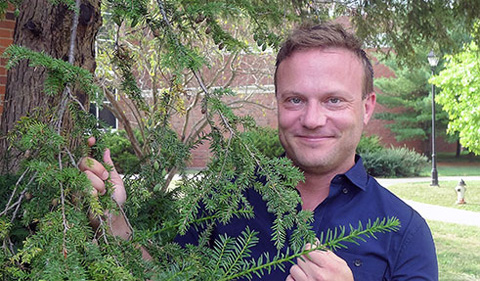Dr. Stefan Little recently joined the faculty of the Environmental & Plant Biology Department at Ohio University as a Visiting Assistant Professor. He hails from Edmonton, Alberta, Canada, where he completed his undergraduate degree as well as a Ph.D. in Systematics and Evolution at the University of Alberta.
“Broadly speaking, my research attempts to integrate paleontological and neontological data into a phylogenetic context. I think that an integrative, organismal approach is an essential part of the study of plant evolution. I find interdisciplinary approaches the most satisfying. I incorporate techniques drawn from geology, plant morphology, developmental anatomy, systematics, proteomics, and genetics. My research involves fieldwork, collections (i.e. herbaria, living collections, and fossil collections), and laboratory studies.
“Lately I have been interested in the evolution of seed plants. Seeds evolved in the Devonian, and by the Permian, there is fossil evidence for all the extant lineages of seed plants, except for the Pine family and the flowering plants. These groups have fossils first appearing in the Jurassic and the Cretaceous, respectively. There are more extinct seed plants lineages than what is left today, and understanding this fossil record is one of the only ways to interpret the evolutionary transitions that have occurred. Many of the relationships among these extinct and extant lineages remain uncertain,” he says.
“Recently I have participated in collaborations on the pollination biology of modern conifers in order to better interpret the fossil record. Developing larger and more detailed data-sets for modern species remains a challenge because many gymnosperms have difficult life-cycles often with a long period between events in sexual reproduction, with organs high on trees that are harder to sample than a laboratory angiosperm. Nevertheless, recent efforts have yielded some interesting results indicating that nectar-like fluids may have evolved early in seed plant evolution, and were not necessarily an innovation of flowering plants.
“I am happy be at OHIO teaching the next generation of scientists and science allies about plant biology.”
Little is teaching both a lower- and upper-level plant structure and development course, Plants and People, as well as the Ohio Flora.


















Comments